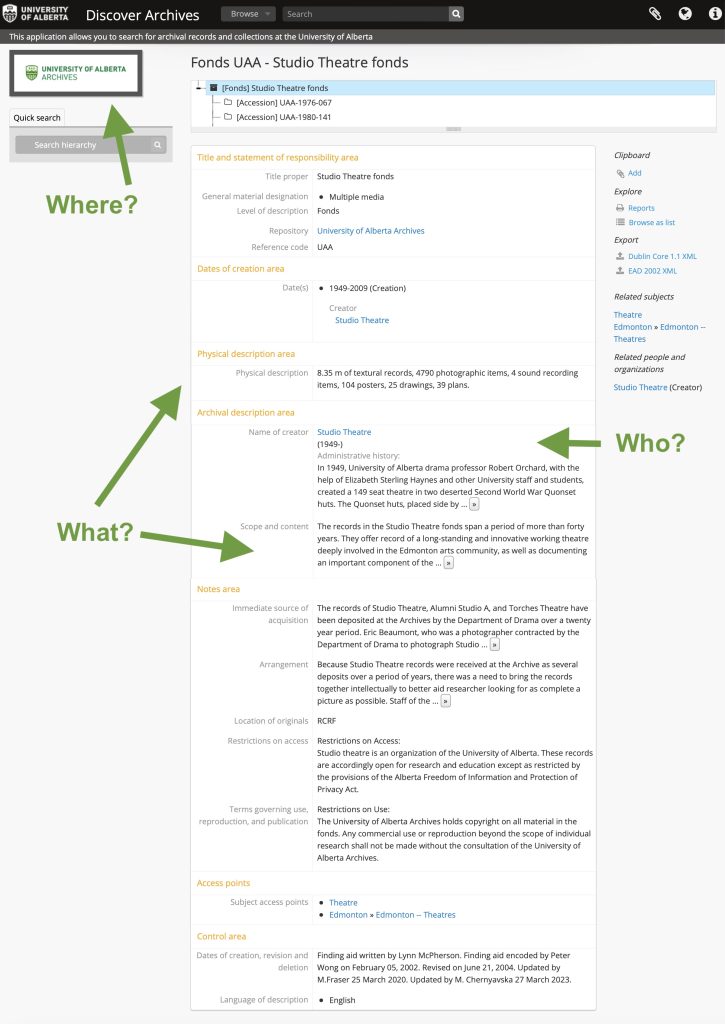This post was written by Digital Archivist, Maryna Chernyavska
In previous posts, we introduced you to the University of Alberta Archives and some of the ways you can search our holdings, and shared some tips on how to search the Discover Archives database. Today, we would like you to get to know archival descriptions and how they help you discover archival materials.
You might have noticed that Discover Archives database looks and works very differently from the University of Alberta Library catalogue. If the library catalogue allows searching for a book or a journal or even an article, archival databases usually describe groups of materials on a fonds or collection level, and much less often individual items within those fonds or collections. Understanding the structure of archival description will help you guide your search and make it more efficient.
It’s all about the context
Archival descriptions provide contextual information about archival materials, and serve as finding aids for users. Essentially, they help users understand the what, who, where, and why of a particular group of materials, and therefore help decide whether these archival records might be useful to them. Let’s explore one description in more detail on the example of the Studio Theatre fonds.
Creators: persons, families, and organizations
Studio Theatre was created at the University of Alberta in 1949 as a laboratory for Drama students. Early participants in Studio Theatre included Robert Orchard, Gordon Peacock, Bert Pullinger, Frank Glenfield, Elizabeth Sterling Haynes, Don Pimm, and Tom Peacocke. It first operated from two deserted WWII Quonset huts before moving to Corbett Hall at the end of 1950s, then from the Myer Horowitz stage in the first half of the 1990s until 1995 when it moved to its current home at the Timm’s Centre. All this information and more can be found in the Administrative history of the archival description. This section tells us WHO created these archival records, what were the functions and daily activities of this organization. If the creator of archival materials was a person or a family, we would see a Biographical note here instead of the Administrative history. The dates in this section refer to the dates when the creators lived (if they were people) or operated.

Repository: where to find the materials
If the user finds the administrative history interesting and relevant to their research needs, it would be good to know where one can find those materials. The answer to the WHERE question can be found in two places: in the top left corner of the description one can see the name and the logo of the University of Alberta Archives. Clicking on them provides the user with information about the location of the archival institution, opening hours, contact information and more. The same page is linked at the top of the description in the Title and statement of responsibility area. In the Discover Archives database, in addition to the University of Alberta Archives, there are three other repositories: University of Alberta Library, Bruce Peel Special Collections, and RCRF.
Finally, the WHAT
The rest of the archival description provides a wealth of information about materials themselves. You would want to examine the Scope and content, as it helps decide if these records are relevant to your interests, and in our example also paint a detailed picture of the contents. The Dates of creation 1949-2009 show that although the Theatre has been operating for the last 74 years, there are no post-2009 records held in the Archives. The Physical description field indicates the media, formats, and extent of the materials: we can see there are over 8 m of paper records and thousands of photographs, but also sound recordings, posters, and drawings. The Notes area helps the user understand access restrictions if any, copyright, etc. The Access points are subject terms that help the discovery of materials and link them with other archival records related to a particular topic.
Finally, the description tree on top of the screen allows the user to see the structure of the fonds, scroll through numerous accessions that are part of it, and see the series into which this fonds was arranged. For example, Accession UAA-1992-022 consists of 1970s photographs of the Fine Arts Centre among other materials.

All of these descriptive elements aim to present archival records in the context of their creation. Knowing the structure of archival descriptions helps you look for exactly the information you need in the right place, and makes your search and research more efficient. Give it a try – find a description you like and see if you can pinpoint the building blocks that together make up an online finding aid.
